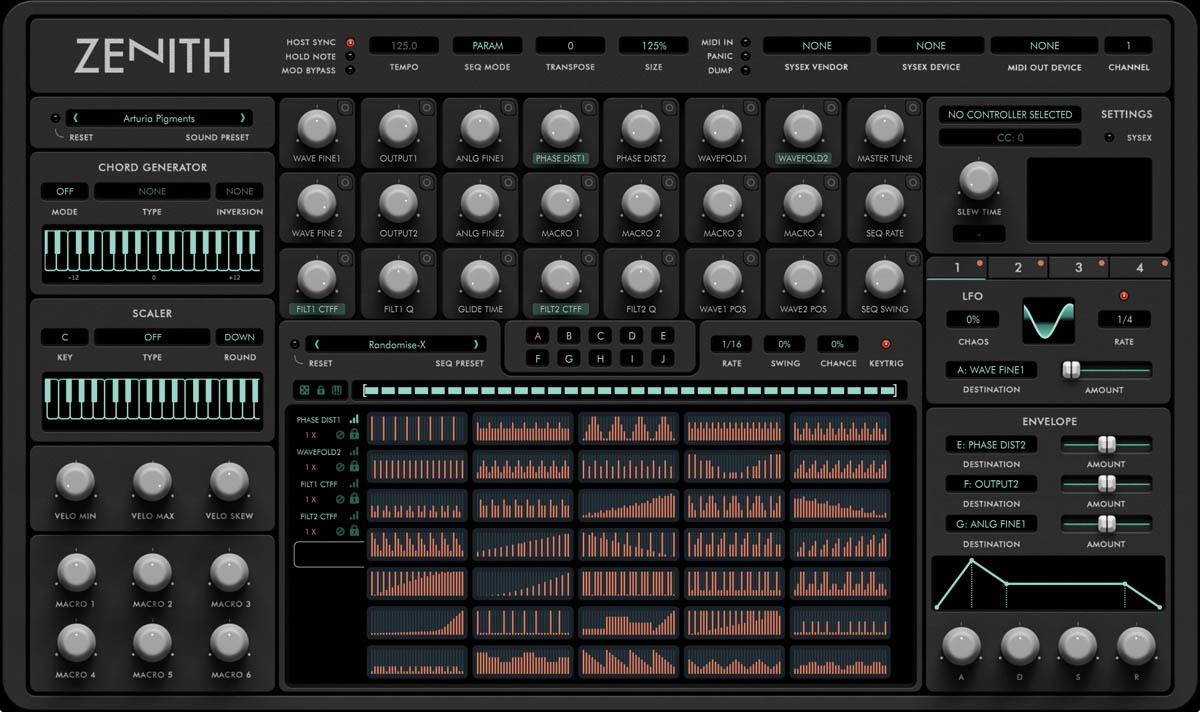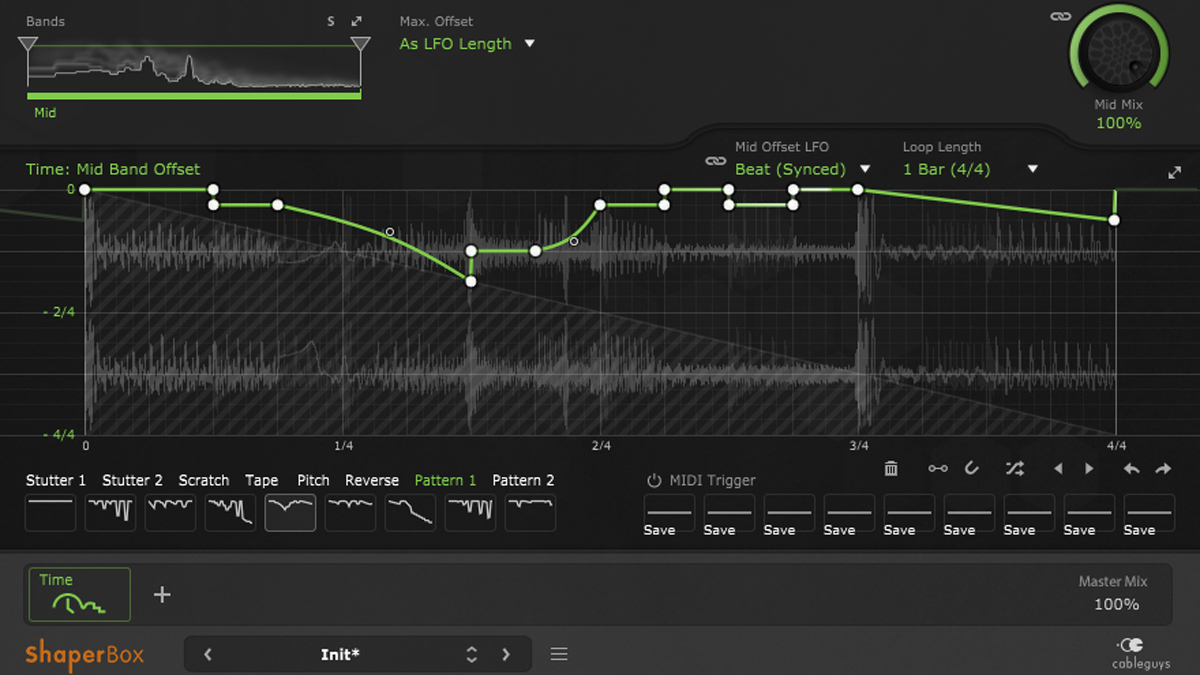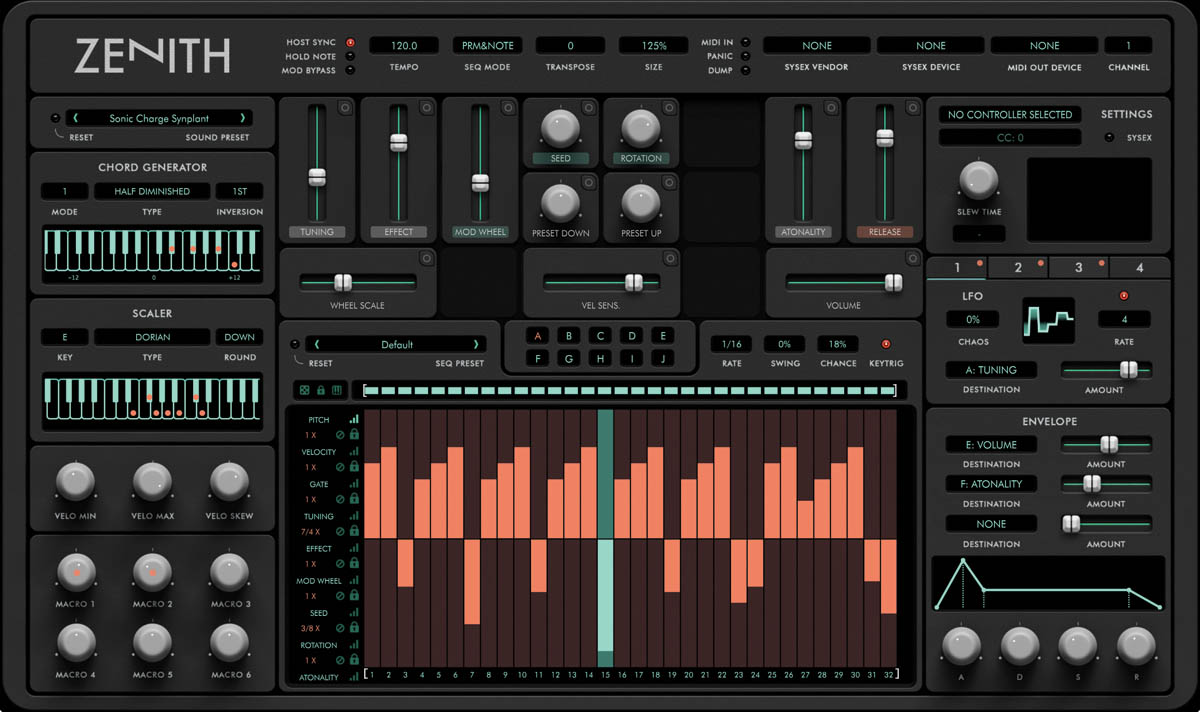MusicRadar Verdict
Powerful, creative and fun, Zenith puts a whole new spin on sound design with synths and MIDI-enabled effects
Pros
- +
Design and sequence your own custom controller sets!
- +
Great sequencer workflow and features.
- +
LFOs, envelope and note modifiers.
- +
SysEx support for many synths.
Cons
- -
Maximum of 24 controllers.
- -
Faders take up two grid slots.
- -
Sequenced controllers don’t animate.
MusicRadar's got your back
What is it?
One of the best features of Audiaire’s Zone synth is its brilliant sequencer, which not only generates note patterns but also automates almost every one of its parameters.
The company’s new plugin, Zenith, is that entire system extracted and repurposed as a VST/AU instrument able to output static, sequenced and modulated MIDI note, Continuous Controller (CC) and SysEx data to any plugin or hardware device capable of receiving it.
As with any plugin that outputs MIDI, setting Zenith up involves a bit of inter-track routing, the specifics of which will depend on your AW, but are by no means difficult to negotiate. Logic Pro X is an exception to this, loading Zenith as a MIDI FX plugin directly on the target track.
It’s also worth noting that it won’t work at all with Reason or any VST3-only host. Zenith’s GUI comprises an array of note sequencing tools (see All the right notes…) and six Macro knobs on the left; a contextual Settings panel, four LFOs and an Envelope generator on the right; and the sequencer in the bottom half of the centre section.
This straightforward interface enables custom MIDI control panels to be built in minutes
Above the sequencer is a blank (by default) ‘controller grid’ of 24 square slots into which knobs and sliders (vertical and horizontal) are freely instantiated in any combination. These are then assigned MIDI CCs and response characteristics (Slew) in the contextual Settings panel.
This straightforward interface enables custom MIDI control panels to be built in minutes, and presets for a wide range of hardware and software synths are onboard, along with matching MIDI mapping templates for those plugins that support them.
These include Xfer Records Serum, Spectrasonics Omnisphere and many instruments and effects by Arturia, u-he and D16. Assignment of controllers to other devices is done using the usual MIDI learn or manual CC entry methods.
Want all the hottest music and gear news, reviews, deals, features and more, direct to your inbox? Sign up here.

Performance and verdict
So far, then, all we’ve done is build an alternative control interface for a set of parameters that we already have access to – but actually, this is all just preparation for Zenith’s primary function, which is modulation of all those CCs in the sequencer, with or without accompanying note/chord sequencing.
Dragging a controller’s name field into the sequencer creates a step lane and assigns that controller’s CC to it. Each lane has its own length (up to 32 steps) and rate multiplier settings (x8 to x1/128) for polyrhythmic programming, and the sequencer can be synced to the host DAW or its own clock, and set to retrigger with incoming notes or run free. Swing and Chance settings dial in shuffle and set the likelihood of each step playing back, respectively.

Step values are set by dragging up and down on them; the Zoom function expands a single lane to fill the whole panel (which otherwise shows eight lanes at once) for detailed editing; and various lane flipping, shifting, scaling and randomising functions are on hand, as well as a collection of arpeggios and scales that are obviously intended mainly for use with the Note sequencer (see All the right notes…), but also serve as interesting modulation shapes.
35 preset single-lane sequences are available for instantly calling up a range of useful shapes (it’s a shame these can’t be user-edited), as is a solid (and expandable) library of multi-lane presets. Up to 10 sequences can be stored in a Zenith patch for real-time and automated switching.

Alongside the sequencer, Zenith also features ‘traditional’ one-shot and cyclical options for modulating the controllers set up in the grid, in the shape of an ADSR envelope and a quartet of LFOs.
The envelope is as basic as they get, but modulates three controllers simultaneously, while the LFOs feature a good range of shapes, phase shift and variable randomisation, and run at rates from 1/128 to 8/1, but can’t be unsynced from the host DAW. Finally, the six Macro knobs are most useful for assigning multiple controllers to single sequencer lanes.
An incredibly dextrous universal modulation source for getting anything that talks MIDI moving, Zenith successfully breaks Zone’s awesome internal sequencing paradigm out into the wider world.
There are, of course, a few niggles, however. First, sequenced (but not LFOand/ or envelope-modulated) controllers are deactivated in the grid, but, confusingly, can still be moved. A coloured box around the controller’s name field indicates its sequenced status, but it would be much better if the controller moved in response to the sequence, or was at least greyed out and ‘killed’.
Next, sliders fill two slots in the grid, eating greedily into the 24-slot maximum, so we’d like to see the option for a smaller one-slot option. That slot limit is itself a concern, too – why not more over multiple pages? And then there’s the lack of a ‘button’ controller – knobs and sliders are assignable to buttons and switches in the target device, but toggling a two-state parameter with a knob is always a slightly awkward business.
That said, Zenith is an easy recommendation. Users of hardware synths probably have the most to gain from it, but a huge part of the appeal is the sequencing of multiple disparate parameters in a single interface, making it a musically inspiring partner to even the most modulation-packed of softsynths.
MusicRadar verdict: Powerful, creative and fun, Zenith puts a whole new spin on sound design with synths and MIDI-enabled effects.
Hands-on demos
Audiaire
Specifications
- Audiaire Zenith
- Type: MIDI processor
- Key Features: Filters, chorder, scaler, LFOs, envelopes, and 24 x 32 step sequencers controlling MIDI CCs, 200+ presets, with pre-configured maps for over 100 devices and is AU / VST2
- Compatibility: PC/Mac
- Audiaire
Computer Music magazine is the world’s best selling publication dedicated solely to making great music with your Mac or PC computer. Each issue it brings its lucky readers the best in cutting-edge tutorials, need-to-know, expert software reviews and even all the tools you actually need to make great music today, courtesy of our legendary CM Plugin Suite.

